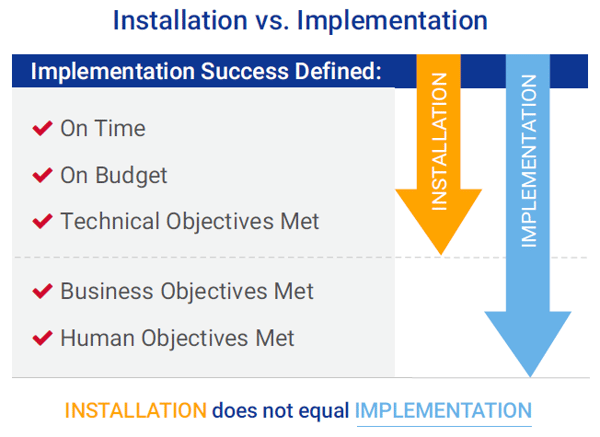If you are currently working on a business change whether is it transformational in scope or a small procedural modification, chances are you are extremely focused on getting to the “go-live” date. Most likely, there are strategies in place and resources dedicated to ensuring the project is going to be on time, on budget and to scope. In other words, once the project is launched you can check the box that it is complete and move on to the next change, right? WRONG! 
“It runs, it hums so we are done” is a problematic mentality shared by many organizations. What these organizations don’t seem to understand is that while getting to launch is certainly a must-do, it is not the endpoint of a project.
The truth of the matter is until you get to sustained behavior change you will not get the financial and other benefits the change is intended to achieve. In plain English…there is no change unless people change their behavior. And that doesn’t happen at launch!
Installation vs Implementation
In every project, there are 5 metrics of success:
- It’s on time
- It’s on budget
- It meets the technical objectives
- The business objectives are met
- The human objectives are met
Installation is when a project meets the first three metrics of being on time, on budget with the technical objectives met. In other words, the project has been launched.
To get to full Implementation, and therefore, full value realization there are two additional success metrics that must also be achieved. Both the business objectives and the human objectives must be met. The human objectives are the behaviors you seek to see in the future. In other words, what will all the people who are impacted by the change be doing differently in the future?
Installation is Seductive
I find most organizations are very good at installing all kinds of changes and it’s easy to understand why. Here are just a few reasons:
- Budget Constraints – Budgets are often developed based on the estimated resources to get to “go-live”, rather than on getting to sustained adoption, and thus value realization for a change.
- Resource Scarcity – Every organization has too many projects all chasing the same, limited resources. To “spread the wealth,” there is enormous pressure to prematurely reassign resources from one project to another quickly.
- Installation is Easy to Quantify – It’s easy to measure if a project is on time, on budget and to scope. It is much more difficult to measure outcomes in terms of behavior change.
- Sponsors are Rewarded for Getting Things Done – Project Teams and leaders are typically rewarded when lots of things “get done.” A list of quickly completed projects can make a manager appear very accomplished!
But when a project is declared finished at the point of cut over (what I like to call premature completion) it is often missing the key resources necessary to get to sustained behavior change and ultimately Return on Investment. It may look like change, but it’s only change at the surface level.
How to Build an Implementation Mentality
To increase the likelihood of success, organizations need to change from an Installation mentality to an Implementation mindset in which they are managing the human objectives of a change. In order to do this, a practical, high-impact change management framework (like the AIM Change Management Methodology) is needed.
Here are a few principles from AIM that will help mitigate the risks on the people side of your change:
- Define the Change in Terms of Human Behavior – If the end goal is to get to adoption and sustained behavior change, then the starting point needs to be a clear and compelling change definition that includes identification of the human behavioral changes in the future state.
- Generate Sponsorship - When you have Sponsors at each level of the organization who are expressing, modeling and reinforcing their commitment to the business change, you will get acceleration.
- Develop a Reinforcement Plan - Reinforcement is the power lever to motivate behavioral changes. If you don’t change the Reinforcement, you won’t get the change. Period.
- Develop Target Readiness to Reduce Time Spent Dealing with Resistance - If you spend some of your resource energy early in the project life cycle on building Readiness (and this requires more than top-down communications through email, a website, or social media) you’ll spend less time and need fewer resources dealing with resistance later.
Leaders who are content with getting to “go-live” or Installation often gain a false sense of satisfaction that change has occurred and therefore, financial return has been achieved. But, by re-framing your definition of success to include all 5 critical success measures you will escape the Installation trap and greatly enhance the likelihood of achieving project ROI. Is Installation important, yes! But full Implementation is the goal you should be striving to meet!



